Spatial beam self-cleaning and supercontinuum generation with Yb-doped multimode graded-index fiber taper based on accelerating self-imaging and dissipative landscape
Tapered optical fibers have been shown to exhibit numerous unique advantages over fibers with longitudinally invariant core diameter, including high output beam quality, high-order-mode (HOM) filtering and broad supercontinuum SC generation [1]. Moreover, active rare-earth doped tapers are used to suppress nonlinear effects in chirped pulse amplifiers, when injecting a beam from the small core side, since pulse amplification is accompanied by a progressive decrease of the nonlinear coefficient, owing to the core diameter increase. However, when injecting a beam into the large core side of a multimode fiber taper, since the self-imaging period is directly proportional to the core diameter, accelerated self-imaging occurs. Indeed, recent experiments have shown that accelerated self-imaging in passive, GRIN MMF permits to broaden the spectral width of SC generation on both the red and the blue side of the pump [2].
Here we study accelerated self-imaging induced nonlinear mode interactions in an active, Yb-doped GRIN multimode fiber taper. Active MMFs are key components for the future generation of multimode fiber lasers, therefore it is important to characterize their spatiotemporal nonlinear response. Combining spectral broadening with Kerr beam self-cleaning in MMFs permits to obtain not only high brightness but also high beam quality SC sources. We demonstrate visible-mid-infrared SC generation and Kerr-indiced beam self-cleaning (KBSC) in a relatively long (∼10 m) active taper, when injecting 500 ps pulses at 1064 nm, propagating in the normal dispersion regime, and from the largest to the smallest taper diameter. We achieve KBSC in a tapered Yb-doped MMF in a lossy configuration (i.e., in the absence of a pump laser diode). In addition, we show that tapering the Yb-doped fiber in the presence of gain induced by a pump laser diode permits to demonstrate KBSC combined with SC generation. Finally, we analyze by the cut-back method the longitudinal evolution of KBSC and SC generation along the taper length. This reveals that accelerated self-imaging, combined with a dissipative landscape, may lead to new, unexpected switching along the propagation direction between self-cleaned modes resembling either the asymmetric LP11 mode or a symmetric flat-top beam, respectively.
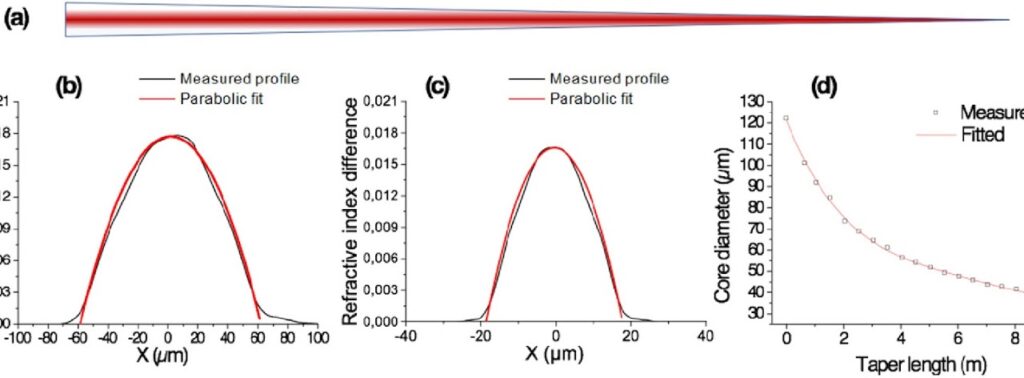
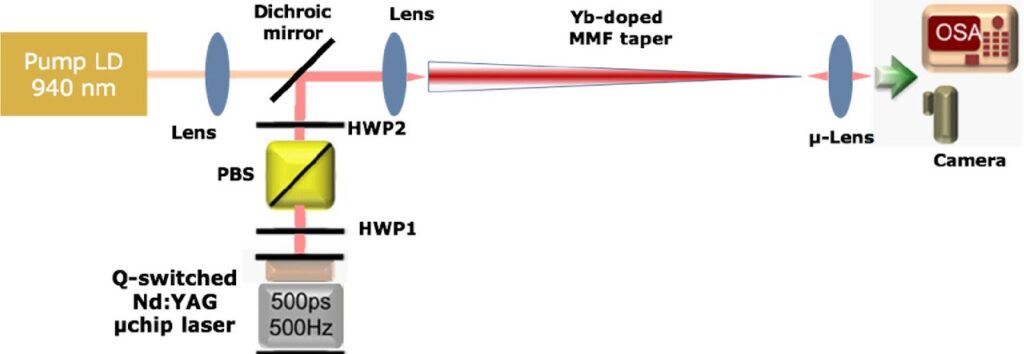
The first experiment was performed in a passive configuration. The signal beam was focused into the core of the Yb-doped GRIN tapered MMFs. The input signal coupled peak power was set first to 0.52 kW, and subsequently it was gradually increased up to 114 kW (the damage threshold of the input tapered face). As shown in Fig. 3(a), the spatial beam pattern at the taper output evolved significantly when increasing the signal power: we observed the transition from a speckled beam into a stable, bell-shaped smooth central beam. This is confirmed by our beam quality factor measurements, as reported in Fig.4. Here we can see that the M2 parameter of the output beam drops and stabilizes to values nearly equal to four. Figure 3(b) shows the output spectra from the tapered MMFs, for different input peak power levels. No significant frequency conversion was observed when progressively increasing the input power, besides the first Raman Stokes sideband.
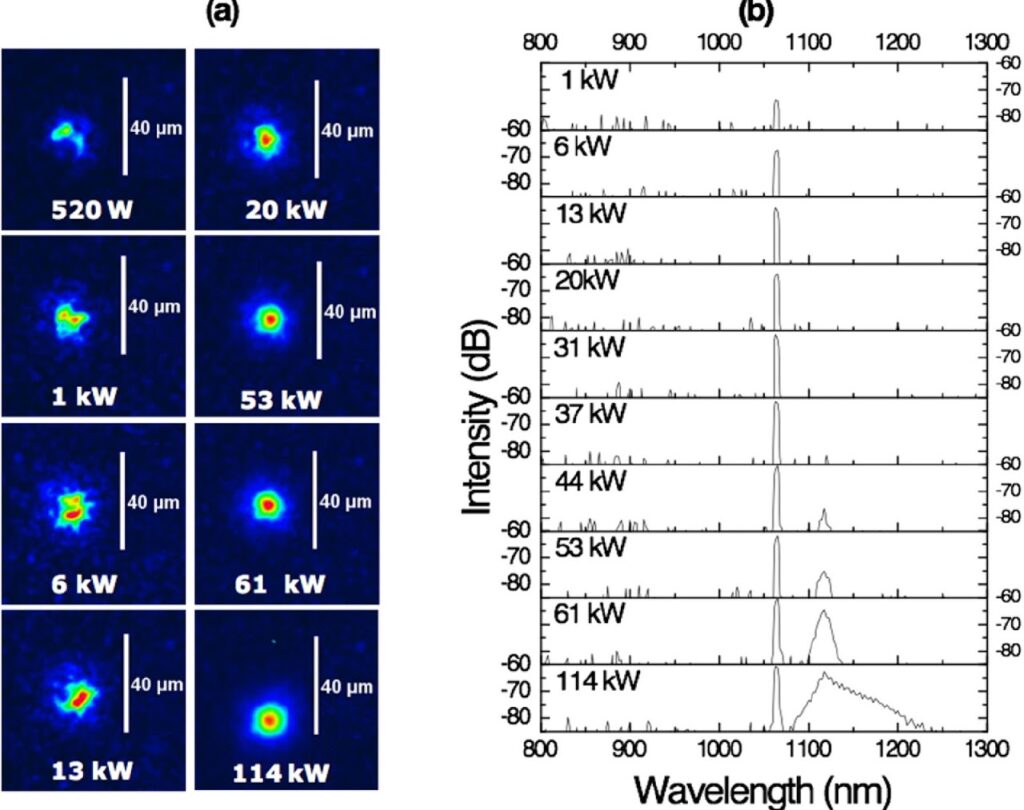
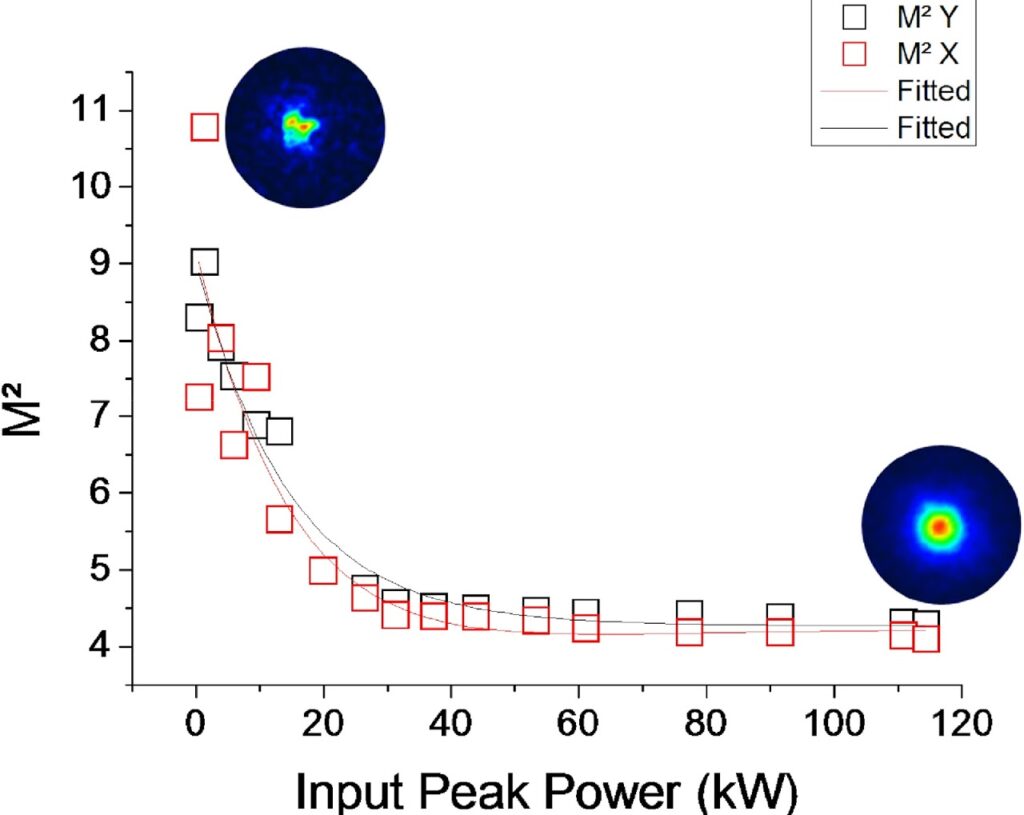
In a second experiment, we added the CW pump source provided by a 940 nm laser diode (LD) delivering up to 10 W, for enabling amplification along the multimode fiber taper. We fixed the signal input peak power at 19.6 kW, just below the KBSC threshold in a passive case. We switched on the pump LD, and gradually increased its power, thus adding a growing amount of gain (G) to the fiber. Note that, owing to the dissipative landscape of our nonlinear active taper, the signal is only amplified over the first 2 m of active fiber, and subsequently it is reabsorbed for longer propagation distances. We observed a progressive reshaping of the guided beam profile into flat-top cleaned beam as the gain G (defined as the ratio between the measured output and input average power of the signal at 1064 nm) was increased. A self-cleaned beam started to form for G = 0.21, and it remained preserved up to G = 1.34, which was the maximum net gain.
After obtaining KBSC, by further increasing the LD pump power we observed the generation of an ultra-broadband supercontinuum. In order to better understand the evolution of the supercontinuum as a function of gain, we present in Fig. 5(a) typical output spectra for varying gain values. As can be observed, up to G = 0.21 the signal is amplified without showing a significant spectral broadening, besides that induced by the stimulated Raman Stokes peak above G = 0.16. By further increasing the gain G, SC generation was obtained starting from G = 0.40. From G = 0.72, an anti-Stokes sideband is observed, which leads to substantial spectral broadening on the blue side of the signal laser. We attribute the origin of the anti-Stokes sideband to GPI. From Fig. 5(b), we can observe that for G = 1.34 the input signal evolves into a remarkably broad SC spanning between 520 nm and 2600 nm.
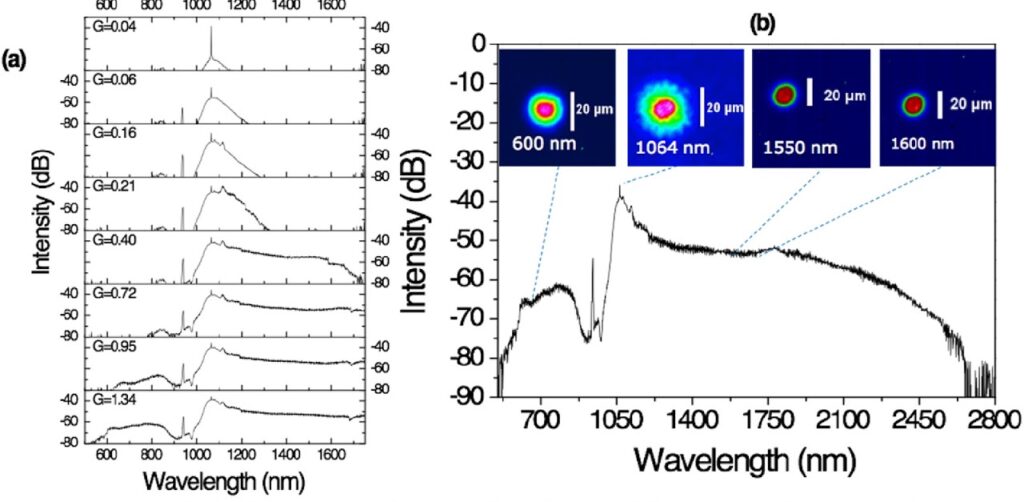
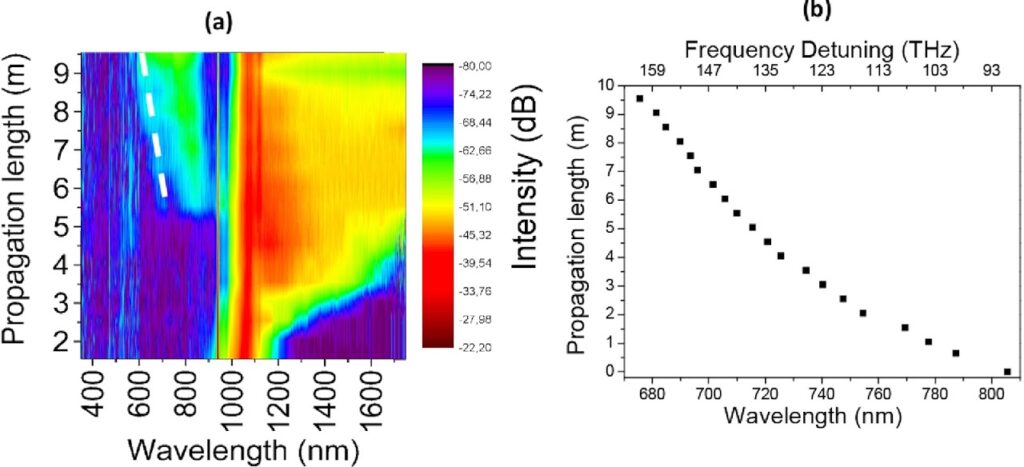
The SC generation process results from a complex interplay of Raman scattering, soliton-self-frequency shift, and spatiotemporal instabilities (or GPI) of light propagating in GRIN MMFs. On the red-shifted side of the input signal, SRS combined with four-wave mixing is the main mechanism for SC generation. As can be seen in Fig. 5, the SC extends well beyond 1300 nm, hence the corresponding spectrum propagates in the anomalous dispersion regime, and solitons subject to Raman self-frequency shift can be generated. Whereas GPI sidebands provide a seed that fosters subsequent SC generation on the blue side of the signal, between 600 nm and 800 nm, by parametric amplification of the GPI signal. Since the square of the sideband frequency shift approximatively is inversely proportional to the decreasing self-imaging period, accelerating self-imaging in the taper leads to a progressive blue-shift of GPI sidebands, which largely expands the overall range of spectral broadening. This is obtained at the expense of a decrease in the parametric frequency conversion efficiency, because of the continuous shifting of the phase-matching condition for parametric gain.
In order to analyze the spatial and spectral beam dynamics induced by accelerating self-imaging, we studied the evolution of KBSC and SC generation as a function of taper length (see Fig. 6). We fixed the input peak power of the signal at 19.6 kW, and set the maximum pumping condition (G = 1.34). A cut-back method was used to determine the spatial and spectral beam evolutions along the taper. A 1064 nm optical filter was used at the output of the taper, in order to measure the power of the amplified signal, and to analyze the transverse beam profile. The average power of the amplified signal (at 1064 nm) at the output taper face was measured for different fiber lengths.
- T. Birks, W. J. Wadsworth, and P. S. J. Russell, “Supercontinuum generation in tapered fibers,” Opt. Lett. 25(19), 1415 (2000)
- M. A. Eftekhar, Z. Sanjabi-Eznaveh, H. E. L. Aviles, S. Benis, J. E. Antonio-Lopez, M. Kolesik, A. Schülzgen, F. W. Wise, R. A. Correa, and D. N. Christodoulides, “Accelerated nonlinear interactions in graded-index multimode fibers,” Nat. Commun. 10(1), 1638 (2019).
